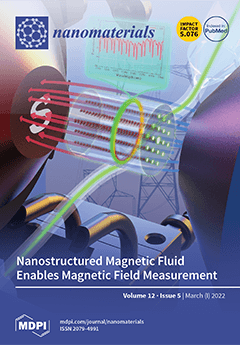In this paper, the fabrication and electrical performance optimization of a four-levels vertically stacked Si
0.7Ge
0.3 channel nanowires gate-all-around transistor are explored in detail. First, a high crystalline quality and uniform stacked Si
0.7Ge
0.3/Si film is achieved by
[...] Read more.
In this paper, the fabrication and electrical performance optimization of a four-levels vertically stacked Si
0.7Ge
0.3 channel nanowires gate-all-around transistor are explored in detail. First, a high crystalline quality and uniform stacked Si
0.7Ge
0.3/Si film is achieved by optimizing the epitaxial growth process and a vertical profile of stacked Si
0.7Ge
0.3/Si fin is attained by further optimizing the etching process under the HBr/He/O
2 plasma. Moreover, a novel ACT@SG-201 solution without any dilution at the temperature of 40 °C is chosen as the optimal etching solution for the release process of Si
0.7Ge
0.3 channel. As a result, the selectivity of Si to Si
0.7Ge
0.3 can reach 32.84 with a signature of “rectangular” Si
0.7Ge
0.3 extremities after channel release. Based on these newly developed processes, a 4-levels vertically stacked Si
0.7Ge
0.3 nanowires gate-all-around device is prepared successfully. An excellent subthreshold slope of 77 mV/dec, drain induced barrier-lowering of 19 mV/V, I
on/I
off ratio of 9 × 10
5 and maximum of transconductance of ~83.35 μS/μm are demonstrated. However, its driven current is only ~38.6 μA/μm under V
DS = V
GS = −0.8 V due to its large resistance of source and drain (9.2 × 10
5 Ω). Therefore, a source and drain silicide process is implemented and its driven current can increase to 258.6 μA/μm (about 6.7 times) due to the decrease of resistance of source and drain to 6.4 × 10
4 Ω. Meanwhile, it is found that a slight increase of leakage after the silicide process online results in a slight deterioration of the subthreshold slope and I
on/I
off ratio. Its leakage performance needs to be further improved through the co-optimization of source and drain implantation and silicide process in the future.
Full article






